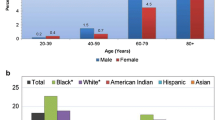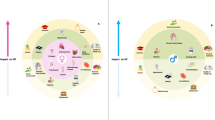Abstract
Some of the most profound sex differences in cardiovascular disease are evident in the syndrome of heart failure. Certain heart failure conditions have a unique predilection for women, such as heart failure with preserved ejection fraction and apical ballooning syndrome; or are exclusive to women, such as peripartum cardiomyopathy. Overall, there are notable differences between women and men in terms heart failure disease burden, risk factors, clinical presentation and prognosis. Yet, women remain under-represented in heart failure clinical trials. Important knowledge gaps exist in our understanding of the pathophysiologic basis for these sex differences and potential for effective sex-specific management strategies.

Similar content being viewed by others
References
Papers of particular interest, published recently, have been highlighted as: • Of importance •• Of major importance
Velagaleti RS, Gona P, Larson MG, et al. Multimarker approach for the prediction of heart failure incidence in the community. Circulation. 2010;122:1700–6.
Roger VL, Go AS, Lloyd-Jones DM, et al. Heart disease and stroke statistics−−2012 Update: a report from the American Heart Association. Circulation. 2012;125:e2–220.
Owan TE, Hodge DO, Herges RM, et al. Trends in prevalence and outcome of heart failure with preserved ejection fraction. N Engl J Med. 2006;355:251–2594.
Borlaug BA, Redfield MM. Diastolic and systolic heart failure are distinct phenotypes within the heart failure spectrum. Circulation. 2011;123:2006–14.
Hsich EM, Pina IL. Heart failure in women: A need for prospective data. J Am Coll Cardiol. 2009;54:491–8.
Rho RW, Patton KK, Poole JE, et al. Important differences in mode of death between men and women with heart failure who would qualify for a primary prevention implantable cardioverter-defibrillator. Circulation. 2012;126:2402–7.
•• Martinez-Selles M, Doughty RN, Poppe K, et al. Gender and survival in patients with heart failure: interactions with diabetes and aetiology. Results from the MAGGIC individual patient meta-analysis. Eur J Heart Fail. 2012;14:473–9. This meta-analysis represents the largest assessment of the association of sex and heart failure survival rates.
Hsich EM, Grau-Sepulveda MV, Hernandez AF, et al. Sex differences in in-hospital mortality in acute decompensated heart failure with reduced and preserved ejection fraction. Am Heart J. 2012;163(3):430–7.
•• Scantlebury DC, Borlaug BA. Why women are more likely then men to develop heart failure with preserved ejection fraction? Curr Opin Cardiol. 2011;26:562–8. Why women are more likely then men to develop heart failure with preserved ejection fraction?.
Fujimoto N, Borlaug BA, Lewis GD, et al. Hemodynamic responses to rapid saline loading: the impact of age, sex, and heart failure. Circulation. 2013;127(1):55–62.
Piro M, Della Bona R, Abbate A, et al. Sex-related differences in myocardial remodeling. J Am Coll Cardiol. 2010;55:1057–65.
Petrov G, Regitz-Zagrosek V, Lehmkuhl E, et al. Regression of myocardial hypertrophy after aortic valve replacement: faster in women? Circulation. 2010;122(11 Suppl):S23–8.
De Simone G, Devereux RB, Chinali M, et al. Sex differences in obesity related changes in left ventricular morphology: the strong heart study. J Hypertens. 2011;29:1431–8.
Rossi P, Frances Y, Kingwell BA, et al. Gender differences in artery wall biomechanical properties throughout life. J Hypertens. 2011;29:1023–33.
Borlaug BA. Sex, load and relaxation; are women more susceptible to load-dependent diastolic dysfunction? J Am Coll Cardiol. 2011;57:1234–6.
•• Borlaug BA, Paulus WJ. Heart failure with preserved ejection fraction: pathophysiology, diagnosis, and treatment. Eur Heart J. 2011;32(6):670–9. Heart failure with preserved ejection fraction: pathophysiology, diagnosis, and treatment.
• Lam CS, Donal E, Kraigher-Krainer E, et al. Epidemiology and clinical course of heart failure with preserved ejection fraction. Eur J Heart Fail. 2011;13(1):18–28. This article gives a comprehensive review of the current epidemiology trends and clinical course and disease outcomes of HFpEF.
Melander O, Maisel AS, Almgren P, et al. Plasma proneurotensin and incidence of diabetes, cardiovascular disease, breast cancer, and mortality. JAMA. 2012;308(14):1469–75.
• Lam CS, Carson PE, Anand IS, et al. Sex differences in clinical characteristics and outcomes in elderly patients with heart failure and preserved ejection fraction: the i-preserve trial. Circ Heart Fail. 2012;5(5):571–8. This article represents the largest and most representative study of HFpEF with a sex-specific analysis and outcomes.
Looi JL, Wong CW, Khan A, et al. Clinical characteristics and outcome of apical ballooning syndrome in Auckland, New Zealand. Heart Lung Circ. 2012;21(3):143.
Brinjikji W, El-Sayed AM, Salka S. In-hospital mortality among patients with takotsubo cardiomyopathy: a study of the National Inpatient Sample 2008 to 2009. Am Heart J. 2012;164(2):215–21.
• Eitel I, von Knobelsdorff-Brekenhoff F, Bernhardt P, et al. Clinical characteristics and CV magnetic resonance findings in stress (Takotsubo) cardiomyopathy. JAMA. 2011;306:277–86. This article describes the clinical characteristics of ABS is a large multicenter cohort, and has the largest magnetic resonance imaging series of ABS to date.
Maron BJ, Towbin JA, Thiene G, et al. American Heart Association; Council on Clinical Cardiology, Heart Failure and Transplantation Committee; Quality of Care and Outcomes Research and Functional Genomics and Translational Biology Interdisciplinary Working Groups; Council on Epidemiology and Prevention. Contemporary definitions and classification of the cardiomyopathies: an American Heart Association Scientific Statement from the Council on Clinical Cardiology, Heart Failure and Transplantation Committee; Quality of Care and Outcomes Research and Functional Genomics and Translational Biology Interdisciplinary Working Groups; and Council on Epidemiology and Prevention. Circulation. 2006;113(14):1807–16.
Deshmukh A, Kumar G, Pant S, et al. Prevalence of Takotsubo cardiomyopathy in the United States. Am Heart J. 2012;164(1):66–71.
Cacciotti L, Passaseo I, Marazzi G, et al. Observational study on Takotsubo-like cardiomyopathy: clinical features, diagnosis, prognosis and follow-up. BMJ Open. 2012;2:e001165.
• Elkayam U. Clinical characteristics of peripartum cardiomyopathy in the United States: diagnosis, prognosis, and management. J Am Coll Cardiol. 2011;58(7):659–70. Clinical characteristics of peripartum cardiomyopathy in the United States: diagnosis, prognosis, and management.
Sliwa K, Hilfiker-Kleiner D, Petrie MC, et al. Current state of knowledge on aetiology, diagnosis, management, and therapy of peripartum cardiomyopathy: a position statement from the Heart Failure Association of the European Society of Cardiology Working Group on peripartum cardiomyopathy. Eur J Heart Fail. 2010;12:767–78.
Burlingame J, Horiuchi B, Ohana P, et al. The contribution of heart disease to pregnancy-related mortality according to the pregnancy mortality surveillance system. J Perinatol. 2012;32(3):163–9.
Biteker M, Ilhan E, Biteker G, et al. Delayed recovery in peripartum cardiomyopathy: an indication for long-term follow-up and sustained therapy. Eur J of Heart Fail. 2012;14(8):895–901.
Goland S, Bitar F, Modi K, et al. Evaluation of the clinical relevance of baseline left ventricular ejection fraction as a predictor of recovery or persistence of severe dysfunction in women in the United States with peripartum cardiomyopathy. J Card Fail. 2011;17(5):426–30.
Biteker M, Duran NE, Kaya H, et al. Effect of levosimendan and predictors of recovery in patients with peripartum cardiomyopathy, a randomized clinical trial. Clin Res Cardiol. 2011;100:571–7.
Gevaert S, Van Belleghem Y, Bouchez S, et al. Acute and critically ill peripartum cardiomyopathy and ‘bridge to’ therapeutic options: a single center experience with intra-aortic balloon pump, extra corporeal membrane oxygenation and continuous-flow left ventricular assist devices. Crit Care. 2011;15:R93.
Sliwa K, Blauwet L, Tibazarwa K, et al. Evaluation of bromocriptine in the treatment of acute severe peripartum cardiomyopathy: a proof-of-concept pilot study. Circulation. 2010;121(13):1465–73.
Ballo P, Betti I, Mangialavori G, et al. Peripartum Cardiomyopathy Presenting with Predominant Left Ventricular Diastolic Dysfunction: Efficacy of Bromocriptine. Case Rep Med. 2012;2012:476903.
Safirstein JG, Ro AS, Grandhi S, et al. Predictors of left ventricular recovery in a cohort of peripartum cardiomyopathy patients recruited via the internet. Int J Cardiol. 2012;154(1):27–31.
Mandal D, Mandal S, Mukherjee D, et al. Pregnancy and subsequent pregnancy outcomes in peripartum cardiomyopathy. J Obstet Gynaecol Res. 2011;37:222–7.
Pyatt JR, Dubey G. Peripartum cardiomyopathy: current understanding, comprehensive management review and new developments. Postgrad Med J. 2011;87:34–9.
Funding
CSPL is supported by a Clinician Scientist Award from the National Medical Research Council of Singapore and a L’Oreal Women In Science Award from L’Oreal and UNESCO.
Conflict of Interest
Ting T. Low declares that she has no conflict of interest.
Carolyn S.P. Lam declares that she has no conflict of interest.
Author information
Authors and Affiliations
Corresponding author
Rights and permissions
About this article
Cite this article
Low, T.T., Lam, C.S.P. Women and Heart Failure: An Emerging Venus-Mars Concept. Curr Cardiovasc Risk Rep 7, 212–216 (2013). https://doi.org/10.1007/s12170-013-0307-z
Published:
Issue Date:
DOI: https://doi.org/10.1007/s12170-013-0307-z




